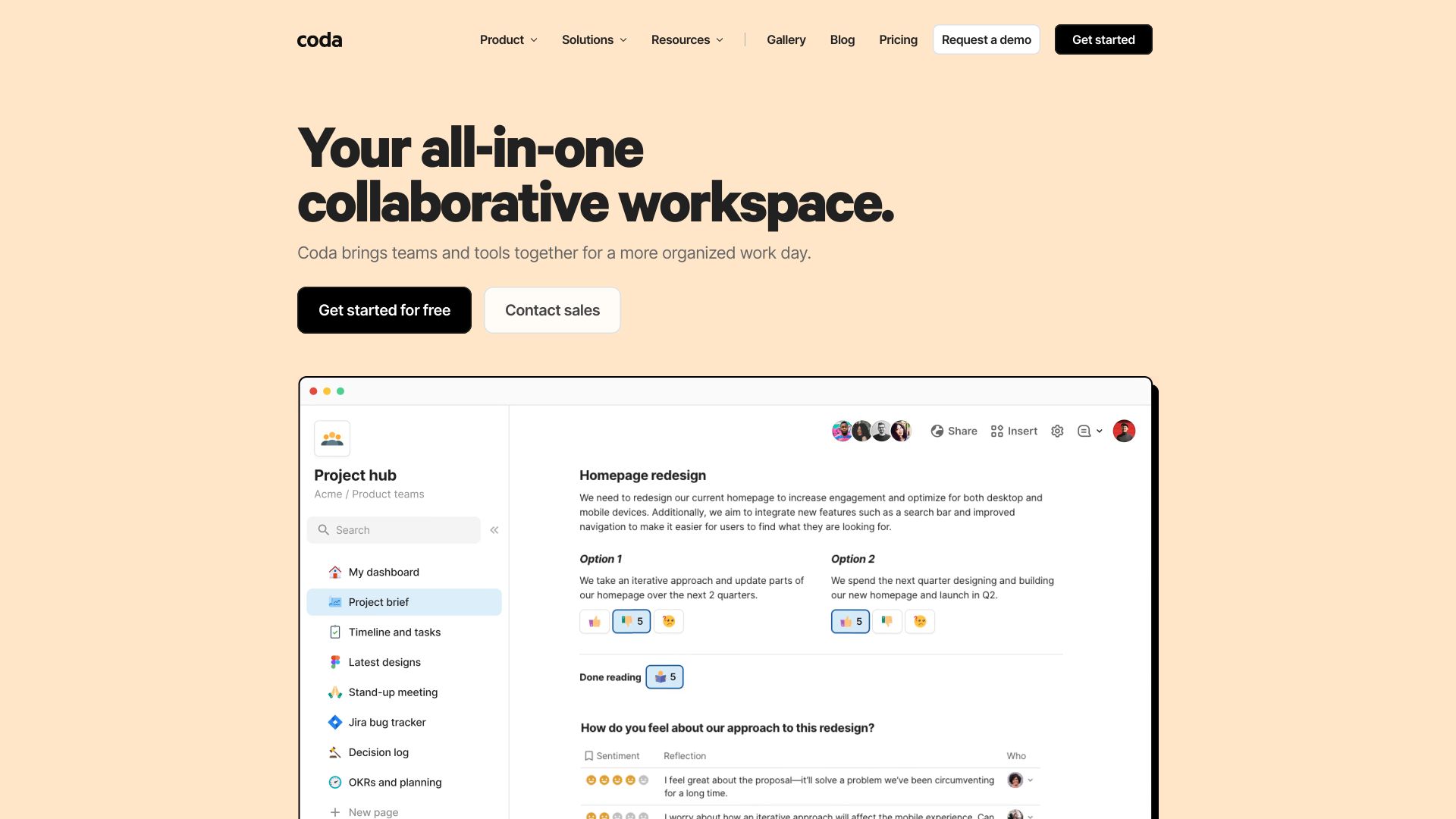- Home
- No-Code&Low-Code
- Coda

Coda
Open Website-
Tool Introduction:AI vocal remover and stem splitter; clean vocals, no quality loss.
-
Inclusion Date:Oct 21, 2025
-
Social Media & Email:
Tool Information
What is Coda AI
Coda AI is the intelligence layer inside Coda, an all‑in‑one workspace that blends the flexibility of docs, the structure of spreadsheets, and the power of lightweight apps. It uses your document’s context—pages, tables, and views—to draft content, summarize notes, reason over data, and trigger automations. Teams can build custom solutions and templates that connect work, reduce tool switching, and keep projects organized. With Packs integrations and AI-powered columns, Coda AI helps product, ops, sales, and marketing teams move from ideas to execution in one place.
Coda AI main features
- Context-aware writing and summarization: Generate drafts, outlines, meeting notes, and concise summaries that reference the doc and table data you choose.
- AI tables and columns: Add AI-driven columns to classify, extract, translate, or enrich rows directly in structured tables.
- Reasoning over data: Ask questions about rows, aggregations, and trends to surface insights without complex formulas.
- Reusable prompts and templates: Standardize workflows with prompt blocks and team-ready templates for repeatable tasks.
- Automations with AI: Combine rules and buttons with AI to route updates, create summaries, or draft follow-ups on schedule or triggers.
- Packs integrations: Connect tools like Slack, Google Workspace, Jira, and Salesforce to pull data in and act on it with AI.
- Knowledge base Q&A: Turn docs into searchable, AI-assisted knowledge hubs with citations back to source pages.
- Granular permissions: Share pages and views securely so AI operates within the right scope of data.
- Publishing and embeds: Share live docs, components, and AI-enabled views across teams or the web.
Who should use Coda AI
Coda AI suits cross‑functional teams that manage projects, roadmaps, and knowledge in one place. Product managers, operations leaders, marketers, sales teams, PMOs, consultants, and startups can use it to replace scattered docs and spreadsheets with a connected workspace that drafts content, analyzes tables, and automates updates.
How to use Coda AI
- Create a new Coda doc or open an existing workspace page.
- Structure data with tables and views for tasks, OKRs, assets, or CRM records.
- Open the AI tools to compose prompts or insert an AI block where you want output.
- Provide context by selecting pages, tables, or specific rows for grounded responses.
- Add an AI column to a table to extract, classify, summarize, or translate per row.
- Set up automations or buttons that trigger AI to generate summaries or follow-ups.
- Connect Packs to sync external data and act on it with AI-powered workflows.
- Turn successful setups into templates and share them with your team.
Coda AI industry use cases
Product teams use Coda AI to summarize customer feedback, groom backlogs, and draft release notes from linked specs. Marketing teams generate campaign briefs, repurpose assets, and maintain an editorial calendar with AI-assisted outlines. Sales teams run a simple CRM in tables where AI summarizes call notes and drafts emails. Operations teams track SOPs and create weekly status digests from task updates. HR and enablement build knowledge hubs that answer employee questions with source citations.
Coda AI pricing
Coda offers free and paid workspace plans, with additional features available on higher tiers. Coda AI is available on select paid plans or as an add‑on, and trials may be offered so teams can evaluate capabilities before committing. Pricing is typically seat‑based with options for larger organizations. For the latest plan details and AI availability, refer to Coda’s official pricing page.
Coda AI pros and cons
Pros:
- Unifies docs, tables, apps, and AI in a single workspace.
- Context-aware outputs grounded in selected pages and data.
- Powerful table workflows via AI columns and automations.
- Strong ecosystem with Packs integrations and reusable templates.
- Granular sharing and view-level controls for secure collaboration.
Cons:
- Learning curve for building robust, app-like docs and prompts.
- Very large docs and tables may require performance tuning.
- AI quality varies by prompt and data; human review is still needed.
- Pricing and seat models can be complex for mixed teams.
- Best results depend on thoughtful data structure and governance.
Coda AI FAQs
-
Question 1: Does Coda AI work with existing tables and views?
Yes. You can target specific tables, rows, and views for summaries, extractions, and classifications, and add AI columns for row-by-row operations.
-
Question 2: Can I connect external tools and data?
Yes. Use Packs to sync data from tools like Slack, Google Workspace, Jira, and Salesforce, then apply AI to analyze or act on that data.
-
Question 3: Is my data secure when using Coda AI?
Coda provides enterprise-ready controls and scoped permissions so AI only uses the content you authorize. Review Coda’s security and privacy documentation for details.
-
Question 4: Can I standardize prompts for my team?
Yes. Save reusable prompts and templates so teams can run consistent, repeatable workflows across docs.
-
Question 5: Are there usage limits?
Usage policies and model limits may apply based on your plan. Check current plan documentation for quotas and fair-use guidelines.




